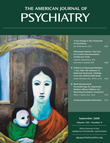Functional Neural Basis of Suicidal Behavior in Depression
To the Editor: In their study, published online March 17 and in the June 2008 print issue of the Journal , Fabrice Jollant, M.D., Ph.D., et al. (1) reported differences in the orbitofrontal cortex activation pattern among euthymic patients with recurrent depression, with and without past suicidal acts. Differences in this activation pattern among euthymic patients were compared with those among healthy comparison subjects. These differences were assessed following the presentation of angry, happy, or neutral faces.
Orbitofrontal cortex dysfunction is described as a contributing factor to the core characteristics of borderline personality disorder (2) , particularly impulsivity (3) . In addition, comorbid depressive disorder is common among individuals with borderline personality disorder (4) . Dr. Jollant et al. did not assess axis II disorders but rather personality traits for which data were reported—but not provided in the article—to be without significant difference. Considering the relatively low sample size and Bonferroni correction for multiple testing, influences of personality traits could have been underestimated as a result of such methodological issues. Furthermore, no data regarding whether suicidal acts were attempted during a depressive episode were provided, which could have helped to differentiate between depressive and impulsive suicidality. Data pertaining to the severity of past depressive episodes in the three study groups could have also helped to elucidate this issue.
1. Jollant F, Lawrence NS, Giampietro V, Brammer MJ, Fullana MA, Drapier D, Courtet P, Phillips ML: Orbitofrontal cortex response to angry faces in men with histories of suicide attempts. Am J Psychiatry 2008; 165:740–748Google Scholar
2. Silbersweig D, Clarkin JF, Goldstein M, Kernberg OF, Tuescher O, Levy KN, Brendel G, Pan H, Beutel M, Pavony MT, Epstein J, Lenzenweger MF, Thomas KM, Posner MI, Stern E: Failure of frontolimbic inhibitory function in the context of negative emotion in borderline personality disorder. Am J Psychiatry 2007; 164:1832–1841Google Scholar
3. Berlin HA, Rolls ET, Iversen SD: Borderline personality disorder, impulsivity, and the orbitofrontal cortex. Am J Psychiatry 2005; 162:2360–2373Google Scholar
4. Zanarini MC, Frankenburg FR, Dubo ED, Sickel AE, Trikha A, Levin A, Reynolds V: Axis I comorbidity of borderline personality disorder. Am J Psychiatry 1998; 155:1733–1739Google Scholar



